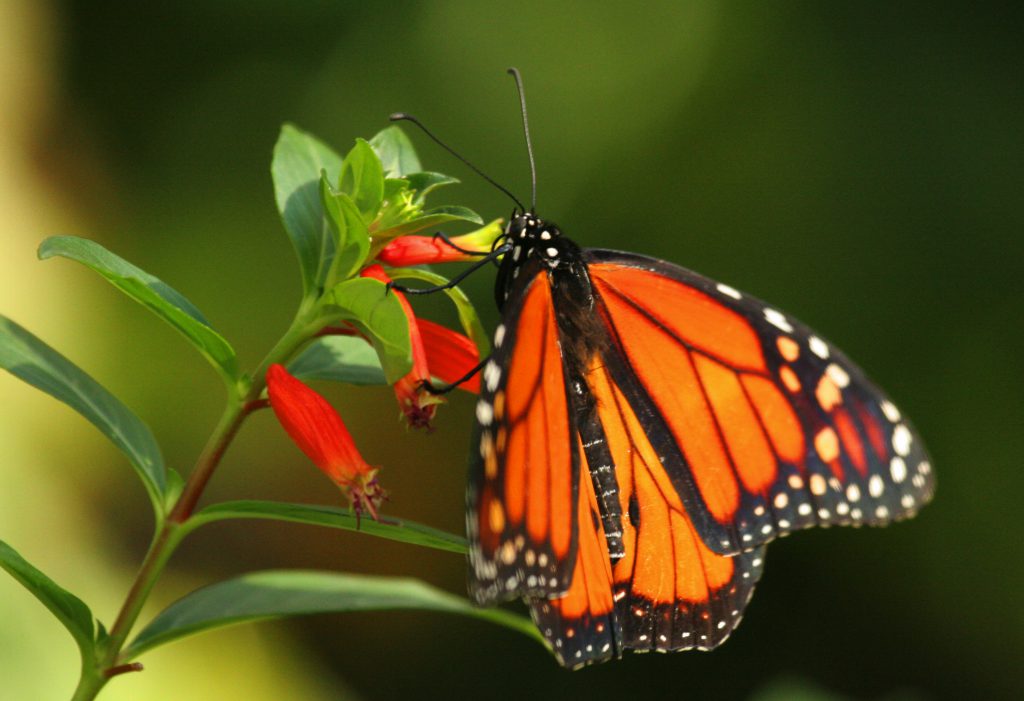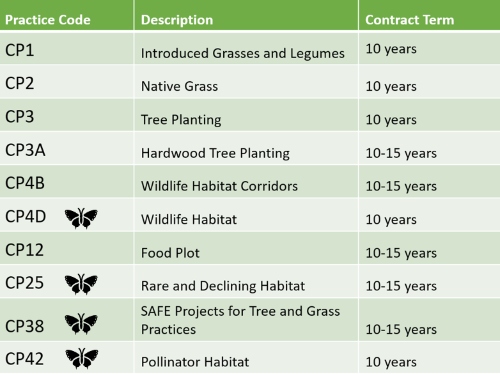
Butterfly feeding. Credit: Farmers for Monacrhs
The February 28 deadline for open enrollment in the USDA Farm Service Agency Conservation Reserve Program (CRP) is fast approaching in a year that will feature one of the largest program acreages ever offered to landowners in the United States.
This article details specific ways farmers and landowners can enroll in certain programs that will provide cash incentives to benefit monarch butterflies and other pollinators. Read on to learn about the general CRP sign-up, continuous signup, important dates, which programs benefit pollinators, and how to increase your chances of enrollment.
“CRP signups heading into 2020 represent significant opportunities for landowners, wildlife, economic development in rural communities and the nation’s most pressing conservation needs,” said Jim Inglis, Pheasants Forever and Quail Forever’s director of governmental affairs in a December 2019 press release.
The CRP also provides opportunities for farmers looking to help conserve the monarch butterfly while continuing to have productive farmlands. As Farmers for Monarchs is dedicated to bringing high quality vetted information to farmers and landowners, we have listed additional information below about CRP enrollment compiled by Pheasants Forever’s Jake Swafford, a Farm Bill Wildlife Biologist.
Highlights for Pollinators in CRP
Pollinator Habitat (CP42) can be offered in General or Continuous Signup. This is the first time CP42 has been available as a stand-alone practice in General CRP. Under General CRP there is no maximum acreage for this practice making it a great option for landowners interested in establishing whole or partial fields to pollinator habitat. Highly sensitive lands, like field borders or areas near streams and ponds, may be best offered under Continuous CRP. For more information, see the USDA’s fact sheet on pollinator habitat planting.
General CRP Cheat Sheet
General CRP signups are competitive and for landowners to earn the best chance of being accepted they’ll need to maximize their Environmental Benefits Index (EBI) score. Selecting a practice made up of diverse native species like Pollinator Habitat (CP42), SAFE Projects (CP38), Rare and Declining Habitat (CP25), and Wildlife Habitat (CP4D) will allow landowners to maximize EBI scores while providing quality pollinator habitat. To further boost the odds of their offer being accepted, landowners should consider adding pollinator habitat plots to their planting. These plots can add EBI points to any practice offered during the general signup, not just those traditionally thought of as wildlife beneficial. For more on the EBI and what factors you can influence, see the information below.
CRP General Sign-up 54 runs from Dec. 9, 2019 to Feb. 28, 2020.
General CRP Practices

*CP 42 practice is an eligible practice for both general and continuous offers.
![]() Best Potential to Benefit Pollinators and Monarchs
Best Potential to Benefit Pollinators and Monarchs
–
General CRP Environmental Benefits Index (EBI)- Ranking Eligible CRP Offers
Note, the USDA fact sheet on EBI scores, can be found at this link.
- FSA will rank offers according to the Environmental Benefits Index (EBI).
- The EBI ensures that the most environmentally sensitive acres are selected relative to cost and all offers are considered fairly.
- All offers are ranked nationally
- The six EBI factors include:
- N1 – Wildlife Habitat Benefits
- N2 – Water Quality Benefits
- N3 – Erosion Reduction Benefits
- N4 – Enduring benefits
- N5 – Air Quality Benefits
- N6 – Cost
- What EBI factors can you influence?
- N1 – Wildlife Benefits: Wildlife habitat cover selection is the most critical factor impacting wildlife benefits. Native mixes of diverse species generally receive the highest point scores. Points are awarded for cover practices and habitat improvements.
- Three Subfactors (Note N1= N1a+N1b+N1c=100 points)
- N1a – Wildlife Cover (10 to 50 points) – Optimum covers significantly increase score
- N1b – Wildlife Enhancement (0,5,20 Points) – See additional info below
- N1c – Wildlife Priority Zones (0 to 30 points) – Based on location so little control at farm level
- N4 – Enduring Benefits (little to no impact on pollinators)
- N6 – Cost (little to no impact on pollinators)
–
Additional info on N1b- Wildlife Enhancement of Cover
Wildlife Food Plots: 5 points (This has been available in previous signups)
- Annual or permanent food plots
- Up to 10% of the field not to exceed 5 acres per field (minimum of ¼ acre)
Pollinator Habitat: 20 points (This has been available in previous signups)
- Minimum of 1 acre or 10% of acreage offered. At least 0.5 acres in size
- 20-40 wildflower species flowering throughout the year
SAFE: 20 points (This is new for signup 54)
- At least 51% of the acreage offered is located in an approved SAFE project area and SAFE practice
- Acres will be planted to nesting, brood, and winter cover as appropriate
- Generally, a diverse mix that includes native forb mix.
–
Opportunities for Pollinators and Monarchs in General CRP
- Select a diverse native planting like a CP42, 38, 25, or 50pts CP2, to gain highest EBI score
- With any cover type, boost EBI score by selecting Pollinator Habitat or SAFE as a Wildlife Enhancement (N1b)
–
Continuous CRP Cheat Sheet
Under Continuous CRP signup, environmentally sensitive land can be enrolled in CRP at any time. Offers are automatically accepted provided that eligibility requirements are met and there are acres available in the program. This makes Continuous CRP a better option for some landowners. The practices that will provide the most benefit for pollinators and monarchs are Pollinator Habitat (CP42), Habitat Buffers (CP33), and the new Prairie Strip (CP43).
Under the Continuous CRP signup, Pollinator Habitat (CP42) is limited to 10 acres per tract or 10% of offered acres. This makes it a terrific option for creating pollinator habitat on small fields or unprofitable acres but not for larger plantings. Those offers will need to be made under General CRP.
Habitat Buffers (CP33) and Prairie Strips (CP43) both have a requirement that some portion of the offered field stay in agricultural production. This is a great way for producers to target low productivity areas of their operation, or areas of conservation concern (erosion, runoff, etc.), and provide valuable habitat for pollinators and other wildlife.
The Continuous CRP Sign-up 53 is ongoing and will remain open until acre goals are reached. Landowners who wish to reenroll expiring contracts should sign up by August 21st to ensure program deadlines are met.
–
Continuous CRP – Best Options to Benefit Pollinators
Habitat Buffers (CP33)
- 30-120 ft habitat buffers planted along the field edges.
- Enroll crop fields of at least 5 acres.
- Options to enroll only pivot corners
Pollinator Habitat (CP42)
- CP42 can be offered in General or Continuous Signup
- Previously this was only a Continuous practice
- In General Signup – Pollinator habitat can be used to enhance EBI points or offered as a whole field practice
- General Signup does not have a maximum acreage limit
- Under Continuous Signup – CP42 offers are limited to 10 acres per tract or 10% of offered acres.
- Previously the only cap was 100 acres per Farm
Prairie Strips (CP43) *New practice*
- 30 to 120 ft strips in crop fields that make up no more than 25% of total field
- Prairie Strips establish diverse perennial vegetation oriented linearly within row crop fields.
- Where Can Prairie Strips be Placed in a Field?
- Around the edges of a field
- Through the field
- In terrace channels
- Next to waterways
- Pivot corners
